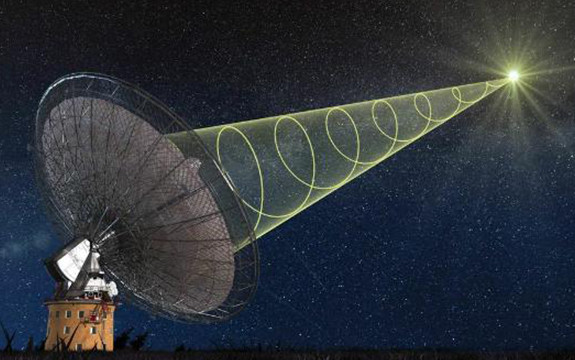Cosmic radio burst caught red-handed

In Summary
Using CSIRO’s 64 metre Parkes radio telescope in eastern Australia, Swinburne University of Technology PhD student Emily Petroff has for the first time seen a ‘fast radio burst’ – a short, sharp flash of radio waves from an unknown source – happening live.
Lasting only milliseconds, the first such radio burst was discovered in 2007 by astronomers combing the Parkes data archive for unrelated objects. Six more bursts, apparently from outside our Galaxy, have now been found with the Parkes telescope and a seventh with the Arecibo telescope in Puerto Rico.
Astronomers worldwide have been vying to explain the phenomenon.
“These bursts were generally discovered week, months or even more than a decade after they happened,” Ms Petroff said.
“We are the first to catch one in real time.”
Confident that she would spot a ‘live’ burst, Ms Petroff had an international team of astronomers poised to make rapid follow-up observations, at wavelengths from radio to X-ray.
A simulation of CSIRO's Parkes radio telescope capturing a fast radio burst as it happened. Video: Swinburne Astronomy Productions
After the Parkes telescope saw the burst go off, the team swung into action on twelve telescopes around the world – in Australia, California, the Canary Islands, Chile, Germany, Hawaii, and India – as well as the Swift Gamma Ray Burst Explorer in space.
“We can rule out some ideas because no counterparts were seen in the optical, infrared, ultraviolet or X-ray,” CSIRO’s Head of Astrophysics, Dr Simon Johnston, CSIRO’s Assistant Director of Astrophysics, said.
"However, the neat idea that we are seeing a neutron star imploding into a black hole remains a possibility."
One of the big unknowns of fast radio bursts is their distances. The characteristics of the radio signal – how it is 'smeared out' in frequency from travelling through space – indicate that the source of the new burst was up to 5.5 billion light-years away.
“This means it could have given off as much energy in a few milliseconds as the Sun does in a day,” Ms Petroff said.
She said identifying the origin of the fast radio bursts is now only a matter of time.
“We’ve set the trap. Now we just have to wait for another burst to fall into it.”
The finding is published in Monthly Notices of the Royal Astronomical Society.
Ms Petroff is co-supervised by CSIRO and Swinburne University of Technology, which is a member institution of the ARC Centre of Excellence for All-sky Astrophysics (CAASTRO).

